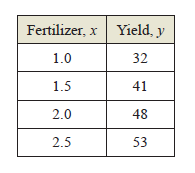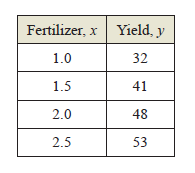
Concept explainers
a.
The solution of the least square regression line for the data.
a.
Answer to Problem 57E
Explanation of Solution
Given information:
An agriculture scientist used four test plot to determine the relationship between wheat yield

Calculation:
The system of the equations are:
To find the least squares regression line
Multiplying the first equation by
Find the value of
Substitute the value of
Thus, the solution is
b.
The demand by using the linear model from part (a).
b.
Answer to Problem 57E
Explanation of Solution
Given information:
An agriculture scientist used four test plot to determine the relationship between wheat yield

Calculation:
By using the linear model from the part (a) to find the value of
Firstly convert the pounds to bushels:
Therefore, the solution is
Chapter 7 Solutions
EBK PRECALCULUS W/LIMITS
- 2. (5 points) Let f(x) = = - - - x² − 3x+7. Find the local minimum and maximum point(s) of f(x), and write them in the form (a, b), specifying whether each point is a minimum or maximum. Coordinates should be kept in fractions. Additionally, provide in your answer if f(x) has an absolute minimum or maximum over its entire domain with their corresponding values. Otherwise, state that there is no absolute maximum or minimum. As a reminder, ∞ and -∞ are not considered absolute maxima and minima respectively.arrow_forwardLet h(x, y, z) = — In (x) — z y7-4z - y4 + 3x²z — e²xy ln(z) + 10y²z. (a) Holding all other variables constant, take the partial derivative of h(x, y, z) with respect to x, 2 h(x, y, z). მ (b) Holding all other variables constant, take the partial derivative of h(x, y, z) with respect to y, 2 h(x, y, z).arrow_forwardmath help plzarrow_forward
- 4. Evaluate the following integrals. Show your work. a) -x b) f₁²x²/2 + x² dx c) fe³xdx d) [2 cos(5x) dx e) √ 35x6 3+5x7 dx 3 g) reve √ dt h) fx (x-5) 10 dx dt 1+12arrow_forwardI just need help with evaluating these limits.arrow_forward3. Differentiate the following functions. Show your work where applicable. a) y = e³x b) f(x)=2 cos(5x) c) y = 1 - 2 d) y = In|secx| e) f(t) = t² e√t f) f(x) = 1+x x sin x 3arrow_forward
 Calculus: Early TranscendentalsCalculusISBN:9781285741550Author:James StewartPublisher:Cengage Learning
Calculus: Early TranscendentalsCalculusISBN:9781285741550Author:James StewartPublisher:Cengage Learning Thomas' Calculus (14th Edition)CalculusISBN:9780134438986Author:Joel R. Hass, Christopher E. Heil, Maurice D. WeirPublisher:PEARSON
Thomas' Calculus (14th Edition)CalculusISBN:9780134438986Author:Joel R. Hass, Christopher E. Heil, Maurice D. WeirPublisher:PEARSON Calculus: Early Transcendentals (3rd Edition)CalculusISBN:9780134763644Author:William L. Briggs, Lyle Cochran, Bernard Gillett, Eric SchulzPublisher:PEARSON
Calculus: Early Transcendentals (3rd Edition)CalculusISBN:9780134763644Author:William L. Briggs, Lyle Cochran, Bernard Gillett, Eric SchulzPublisher:PEARSON Calculus: Early TranscendentalsCalculusISBN:9781319050740Author:Jon Rogawski, Colin Adams, Robert FranzosaPublisher:W. H. Freeman
Calculus: Early TranscendentalsCalculusISBN:9781319050740Author:Jon Rogawski, Colin Adams, Robert FranzosaPublisher:W. H. Freeman
 Calculus: Early Transcendental FunctionsCalculusISBN:9781337552516Author:Ron Larson, Bruce H. EdwardsPublisher:Cengage Learning
Calculus: Early Transcendental FunctionsCalculusISBN:9781337552516Author:Ron Larson, Bruce H. EdwardsPublisher:Cengage Learning





